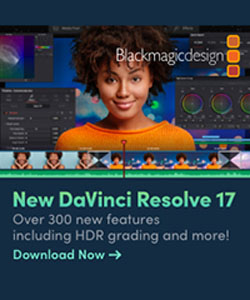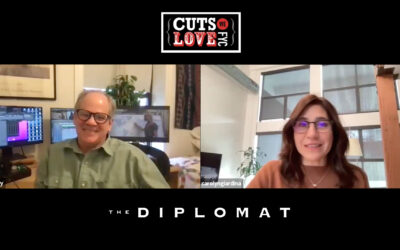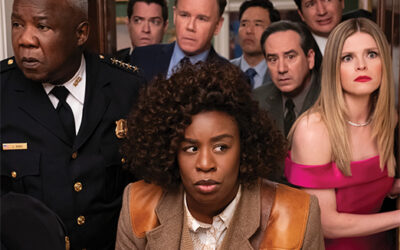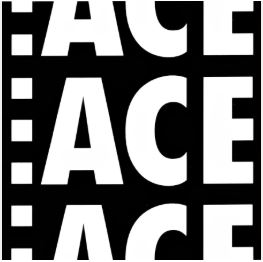December 8, 2020


Director Kenneth Branagh assembles an all-star cast of potential murderers for Death on the Nile, a new feature adaptation of Agatha Christie’s 1937 novel. The followup to 2017’s Murder on the Orient Express, has famous Belgian detective Hercule Poirot tasked with solving the death of an American heiress on board a honeymoon cruise in Egypt. Like Orient Express, it is written for the screen by Michael Green, photographed by Haris Zambarloukos, BSC, with production design by Jim Clay.
The editor on this occasion is Úna Ní Dhonghaíle, ACE, (Three Girls, Stan and Ollie, The Crown) who cut episodes of detective drama Wallander starring Branagh and edited the Branagh directed William Shakespeare tragicomedy All Is True. The whodunnit genre (like the 1978 feature version of Nile starring Peter Ustinov) has been recently satirized by Rian Johnson’s Knives Out with Daniel Craig as a Poirot-esque sleuth complete with rogue accent. CinemaEditor wondered if that had played into the filmmaker’s approach.
“Both Ken and I had seen Knives Out and we loved it but Death has a much darker story and is definitely not a pastiche,” says Ní Dhonghaíle. “Our film is a little more serious than that. Michael wrote a beautiful script that gets under the skin of Poirot a bit more. Ken also wanted that subjectivity and was willing to go darker.”
Ní Dhonghaíle is an Agatha Christie fan and says she enjoyed previous incarnations of Poirot by actors including Peter Ustinov, David Suchet, Ian Holm, Albert Finney, Alfred Molina, even Orson Welles. “Poirot is one of those well-known characters that generations of audiences are willing to take in any form and expression,” she says. “That’s because Christie has created a character that warrants interpretation in different ways.
“What I like about Poirot is that his quirkiness, and things that are deep in his psyche, enable him to solve the riddle.”
Audiences love a good whodunnit because of the fun to be had in teasing out the red herrings from the facts of the case. They like to be their own detective. The trick for the filmmaker is to give an audience just enough rope to play along with, but not quite enough that they guess who did it before the final curtain.
“That’s what I found fun about working on this film,” says Ní Dhonghaíle. “You can plant seeds that are going to pay off later. With a sound or an image that you plant early on and echo later you hope the audience will have a little rush of recollection and think that that person did it. Then five minutes later the suspicion has switched to another person.
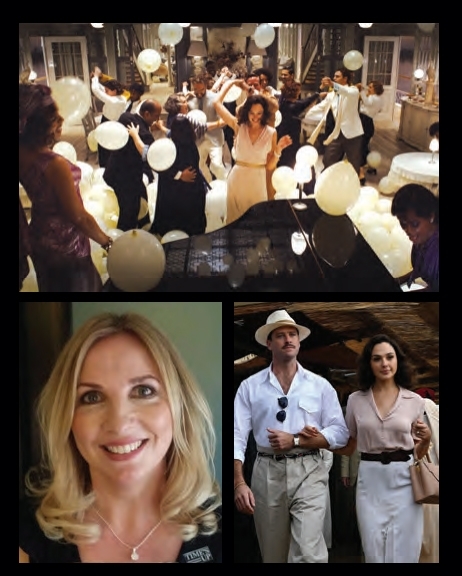 “The script contained all the verbal clues but we had such a strong cast of actors who all seemed to live their characters. I made sure I saw everything that was shot to catch those little ad libs that Ken had encouraged his actors to deliver.” Viewing all the dailies also helped to catch the non-verbal cues. “For example, if there was a little flick of the eye I could steal like a magpie and use it to maybe hold a fraction longer. Or, if there was a big clue and we didn’t want to signpost it, I might be lighter, more implicit – I didn’t linger in the cut.” She adds, “Knives Out celebrates a more pastiche style, using sound design or flashbacks to telegraph clues. In our film we wanted to throw it away a bit more, make it a bit more subtle and not reveal too much that might give the game away. We were mindful of an audience who may not know the book or have seen previous versions, so we want to keep them guessing.”
“The script contained all the verbal clues but we had such a strong cast of actors who all seemed to live their characters. I made sure I saw everything that was shot to catch those little ad libs that Ken had encouraged his actors to deliver.” Viewing all the dailies also helped to catch the non-verbal cues. “For example, if there was a little flick of the eye I could steal like a magpie and use it to maybe hold a fraction longer. Or, if there was a big clue and we didn’t want to signpost it, I might be lighter, more implicit – I didn’t linger in the cut.” She adds, “Knives Out celebrates a more pastiche style, using sound design or flashbacks to telegraph clues. In our film we wanted to throw it away a bit more, make it a bit more subtle and not reveal too much that might give the game away. We were mindful of an audience who may not know the book or have seen previous versions, so we want to keep them guessing.”
Another delight for an audience in watching one of the Christie canon on film is the all-star ensemble. Death On The Nile features Gal Gadot as unfortunate heiress Linnet Ridgeway, with Emma Mackey, Annette Bening, Armie Hammer, Letitia Wright, Sophie Okonedo, Ali Fazal and British comedy stars Jennifer Saunders, Dawn French and Russell Brand.
“The challenge is to craft a picture that meets audience expectations of seeing their favorite actor while balancing the screen time for each without letting the pace slack. We had a really great script with a cast of incredible characters each with their own reason to murder.
“The first cut was massively enjoyable but 40 minutes too long – so the task was to hone it by losing some scenes and collapsing others while maintaining the essence. The challenge of shortening is something I enjoy. You want to feel the visceral nature of the scene by shrinking it or merging things together so that you don’t ever notice anything is missing.”
Principal photography last Autumn was at Longcross Studios, just outside London, where Ní Dhonghaíle was stationed. Having championed her usual assistants to go solo on their own shows, she arrived needing a new team. She quickly called up first assistant Simon Davis and VFX editor Matt Glen, both of whom had worked on Branagh productions before. Joining them were Sarah Bowden second assistant; Katie Nicholls, editorial trainee; and Thora Woodward, assistant VFX editor.
“They were all brilliant. Simon would organize all the rushes. I would start cutting what was shot that day. Then I would give the scenes to Simon and Sarah and they would begin doing sound design,” Ni Dhonghaile says. “Matt was also with us from week one and began painting in any bluescreen backdrops. It meant that by Friday I could send Ken the first-week assembly that looked and sounded pretty good. That’s a good boost for any director. All directors need a good editorial team just to give them a little email to say ‘well done, it’s beautiful’ but for them
to see it is even better.
“Every week I would send [Branagh] that week’s cut but halfway through the shoot I pulled the whole film together so he could view it. We were in constant communication about anything he needed to drop or pick up, but because of time pressures it was a bonus to be able to watch it together at this moment and know where to go from there.” It was also beneficial to project the film, shot on 65mm, at Longcross’ screening rooms for editorial, the camera team, and art department. Glen was able to drop in backdrops from the location shoot in Egypt so Ní Dhonghaíle could cut those in before the VFX department began to work in earnest.
“George Murphy (VFX supervisor) and Claudia Dehmel (VFX producer) were just down the corridor from me at Longcross which was really handy. We had great communication. They shared some early imagery with us of the CG boat which I could put some sound design on and add a push in on a shot to give it more life so that we could better understand how the story was working. Ken is very good at watching work-inprogress VFX and not being put off!”
The film had wrapped by January but editorial was barely begun when COVID-19 forced everyone to quarantine. Ní Dhonghaíle decided to return to Dublin, where she has an Avid-equipped studio, and maintain regular communication with Davis and Glen in England, talking with Branagh every morning.
“We were lucky in being further down the road than some films,” she says. “We’d had a few screenings together and were on our third cut but we had to abandon plans to screen our DCP, with temp mix in L.A. for Disney – which would have been their first screening – because of the COVID restrictions.
“The big thing with the pandemic is that everyone pulled together. From the top executives on down everyone was kindness and consideration,” she adds, noting that Disney Co-Chairmen Alan Bergman and Alan Horn, 20th Century’s president of production Steve Asbell, Michael Green and producer Judy Hofflund “had to review on PIX and I was struck by how gracious they were in accommodating this. They quickly sent over notes to us.
Ken would digest them, attack them and we had another screening one week later, so it was a really quick turnaround.” Ní Dhonghaíle spent two weeks on the sound mix at Twickenham Studios following COVID-safety protocols. “As the VFX came in, Simon would send them to me and I’d cut it in and send on updated reels. If anything needed adjusting we talked it through over the phone. It’s the biggest-budget feature I’ve worked on to date and despite all of the challenges working remotely it proved to be one of the most rewarding because of everyone’s attitude. We were just working as a team and very aware how lucky were to be able to work and blessed that none of us or our families were sick. Everyone took that as a real positive sign to just do our best to finish the film.” With the story in good shape they locked the cut in June giving additional time for VFX to work through shots in remote workflows.
“At film school I studied directing and cinematography and part of our course was on Dead Again (Branagh’s thriller from 1991). I would draw diagrams and mis-en-scene about how he’d placed the camera. So, I was thrilled when I got to work with him years later on Wallander and honored to join him on his journey down the Nile.
Featured in Content:
4th Quarter, 2020
ACE Board Message
FEATURES
Death on the Nile
Hillbilly Elegy
Ted Lasso
Tenet
Trial of Chicago 7
EDITOR’S CUT
EditFest Global Debut
Internship Goes Virtual
STOCK FOOTAGE
Aspects of Editing
Tech Corner
Where the World is Going
Cuts We Love
Related Content
Cuts We Love: “Nobody Wants This”
"Nobody Wants This" Interview by Carolyn Giardina with Maura Corey, ACE, editor of Nobody Wants ThisMore...Explore Your Favorite TopicsEditFestTechnologyInterviewsMoviesNews A short excerpt from the ‘Virtual Glass of Wine’ British Film Editors interview series. David...
Cuts We Love: “The Diplomat”
"The Diplomat" Interview by Carolyn Giardina with Gary Levy, ACE, editor of The DiplomatMore...Explore Your Favorite TopicsEditFestTechnologyInterviewsMoviesNews A short excerpt from the ‘Virtual Glass of Wine’ British Film Editors interview series. David Fairhead BFE...
Explore Your Favorite Topics
EditFest
Technology
Interviews
Movies
News
A short excerpt from the ‘Virtual Glass of Wine’ British Film Editors interview series. David Fairhead BFE talks about the emotions working in the cutting room.
A short excerpt from the ‘Virtual Glass of Wine’ British Film Editors interview series. David Fairhead BFE talks about the emotions working in the cutting room.
A short excerpt from the ‘Virtual Glass of Wine’ British Film Editors interview series. David Fairhead BFE talks about the emotions working in the cutting room.
A short excerpt from the ‘Virtual Glass of Wine’ British Film Editors interview series. David Fairhead BFE talks about the emotions working in the cutting room.
CinemaEditorMag
Television
Editors On Editing
International
All Videos

